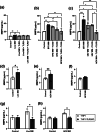Mobiluncus mulieris alters the transcriptomic profile of cervicovaginal epithelial cells, shedding light on molecular drivers of adverse reproductive outcomes
- PMID: 40775239
- PMCID: PMC12331918
- DOI: 10.1038/s41522-025-00784-w
Mobiluncus mulieris alters the transcriptomic profile of cervicovaginal epithelial cells, shedding light on molecular drivers of adverse reproductive outcomes
Abstract
The vaginal microbiota is critical for reproductive health, and its disruption, particularly the loss of Lactobacillus spp. and dominance of anaerobes such as Mobiluncus mulieris (community state type IV, CST IV), is associated with bacterial vaginosis, sexually transmitted infections, and adverse reproductive outcomes, including preterm birth (PTB). While Gardnerella spp. have been widely studied, the role of M. mulieris remains poorly understood. This study used an unbiased discovery approach to examine host-microbe interactions driven by M. mulieris across distinct epithelial barriers of the lower reproductive tract. RNA sequencing revealed that live bacteria, cell-free supernatant, and bacterial extracellular vesicles (bEVs) each induced unique transcriptional responses in epithelial cells. All three components activated immune and inflammatory pathways, with bEVs eliciting the strongest response, particularly via toll-like receptor (TLR) 2 and TLR5 signaling. M. mulieris also altered extracellular matrix (ECM) remodeling pathways, including upregulation of matrix metalloproteinase 9 (MMP9), a key mediator linked to PTB. These findings were supported by clinical data showing elevated MMP9 in pregnant women with M. mulieris-containing vaginal microbiota. Collectively, these results highlight the broad impact of M. mulieris on epithelial responses and identify mechanisms by which specific anaerobes contribute to inflammation and ECM disruption in adverse reproductive outcomes.
© 2025. The Author(s).
Conflict of interest statement
Competing interests: J.R. is co-founder of LUCA Biologics, a biotechnology company focusing on translating microbiome research into live biotherapeutic drugs for women’s health. All other authors declare that they have no competing interests.
Figures






Similar articles
-
Intrauterine colonization with Gardnerella vaginalis and Mobiluncus mulieris induces maternal inflammation but not preterm birth in a mouse model.Am J Reprod Immunol. 2023 Aug;90(2):e13749. doi: 10.1111/aji.13749. Am J Reprod Immunol. 2023. PMID: 37491927 Free PMC article.
-
Alterations in vaginal microbiome in women with short cervix: longitudinal study of microbial diversity and impact of vaginal progesterone treatment.Ultrasound Obstet Gynecol. 2025 Aug;66(2):217-225. doi: 10.1002/uog.29269. Epub 2025 Jun 26. Ultrasound Obstet Gynecol. 2025. PMID: 40569025 Free PMC article.
-
Immunometabolic Analysis of Mobiluncus mulieris and Eggerthella sp. Reveals Novel Insights Into Their Pathogenic Contributions to the Hallmarks of Bacterial Vaginosis.Front Cell Infect Microbiol. 2021 Dec 23;11:759697. doi: 10.3389/fcimb.2021.759697. eCollection 2021. Front Cell Infect Microbiol. 2021. PMID: 35004344 Free PMC article.
-
The vaginal microbiota and preterm birth: A systematic review.Eur J Obstet Gynecol Reprod Biol. 2025 Jul;311:114007. doi: 10.1016/j.ejogrb.2025.114007. Epub 2025 Apr 26. Eur J Obstet Gynecol Reprod Biol. 2025. PMID: 40311386
-
Vaginal pharmacomicrobiomics modulates risk of persistent and recurrent bacterial vaginosis.NPJ Biofilms Microbiomes. 2025 Jul 1;11(1):115. doi: 10.1038/s41522-025-00748-0. NPJ Biofilms Microbiomes. 2025. PMID: 40595711 Free PMC article. Review.
References
-
- van de Wijgert, J. H. H. M. & Jespers, V. The global health impact of vaginal dysbiosis. Res. Microbiol.168, 859–864 (2017). - PubMed
MeSH terms
Substances
Grants and funding
- R01 HD102318/HD/NICHD NIH HHS/United States
- R01HD098867/National Institutes of Health (NIH) National Institute of Child Health and Human Development (NICHD)
- R01 NR014784/NR/NINR NIH HHS/United States
- R01 HD098867/HD/NICHD NIH HHS/United States
- R01NR014784/National Institute for Nursing Research of the National Institutes of Health
LinkOut - more resources
Full Text Sources
Medical
Miscellaneous

